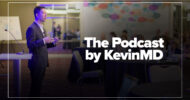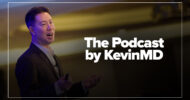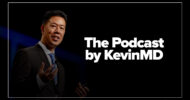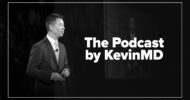Subscribe to The Podcast by KevinMD. Watch on YouTube. Catch up on old episodes!
Orthopedic surgeon Michael Day discusses his article “Why it’s time for doctors to become performance coaches.” Michael explains why public trust in U.S. health care is declining and how patients are increasingly turning to high performers and influencers outside medicine for health inspiration. He argues that physicians must expand their role beyond disease treatment to become performance coaches—providing accountability, context, and specialized knowledge to help patients pursue fitness, resilience, and longevity. Michael emphasizes the lessons learned from elite athletes, the power of exercise in preventing chronic disease, and the importance of patient ownership in a tech-enabled health future. Listeners will gain insights into how physicians can bridge the gap between treatment and performance while rebuilding trust with their patients.
Our presenting sponsor is Microsoft Dragon Copilot.
Want to streamline your clinical documentation and take advantage of customizations that put you in control? What about the ability to surface information right at the point of care or automate tasks with just a click? Now, you can.
Microsoft Dragon Copilot, your AI assistant for clinical workflow, is transforming how clinicians work. Offering an extensible AI workspace and a single, integrated platform, Dragon Copilot can help you unlock new levels of efficiency. Plus, it’s backed by a proven track record and decades of clinical expertise, and it’s part of Microsoft Cloud for Healthcare, built on a foundation of trust.
Ease your administrative burdens and stay focused on what matters most with Dragon Copilot, your AI assistant for clinical workflow.
VISIT SPONSOR → https://aka.ms/kevinmd
SUBSCRIBE TO THE PODCAST → https://www.kevinmd.com/podcast
RECOMMENDED BY KEVINMD → https://www.kevinmd.com/recommended
Transcript
Kevin Pho: Hi, and welcome to the show. Subscribe at KevinMD.com/podcast. Today we welcome back Michael Day. He’s an orthopedic surgeon. Today’s KevinMD article is “Why it’s time for doctors to become performance coaches.” Michael, welcome back to the show.
Michael Day: Thanks for having me, Kevin.
Kevin Pho: I think you were last on a few years ago, and for those that didn’t get a chance to listen to your prior articles, just briefly share your story.
Michael Day: I’m an orthopedic surgeon by training, and my subspecialty in that field was sports medicine. I have a long-time interest in performance and served as a team physician. In that vein, looking for performance for myself and my patients, I really felt that there was a gap for our orthopedic patients between completion of rehab, recovering from their injury, and return to performance.
That got me thinking about what our medical system does well and doesn’t do well, and what gaps there are that we could fill with alternative, more proactive, and more preventative ways, and what we can learn from the sports performance world. I’ve taken a new focus with my practice that focuses on proactive prevention and a performance-oriented approach. That’s where that article grew out of: viewing medicine through the lens of performance.
I think a lot of the discussion in medicine is really, in many ways these days, about what is the role of the doctor and how is that changing? One of the ways that I like to think about it is again, from sports and this idea of the performance coach and how that can be an aspect of doctoring that anyone can incorporate in any field of medicine. The thrust of the argument of that article is that we should take on that role and provide accountability and expertise, and really build trust with the patients in the way that a good coach does.
Kevin Pho: Let’s talk more about that article for those who didn’t get a chance to read it.
Michael Day: I heard Dana White, who’s the president of the UFC, say, “I’ll never go to a doctor for medical advice,” and I hear that more frequently than I would’ve thought from people in my community. As a doctor, it’s kind of shocking at first, but if you pick it apart and understand where they’re coming from, you can really understand where that sentiment comes from. There’s a loss of trust. There’s politicization of messages. There are conflicting messages.
We haven’t done a good job as a medical community of taking ownership over medical information and the patient experience. Everyone’s doing their best within the limitations they have, but a lot of patients have experienced the deterioration of the experience. There’s so much health information that they don’t trust doctors to be on the cutting edge, and they don’t want to wait for interventions to trickle through our typical system of randomized controlled trials, meta-analyses, and the building of an evidence base, which we rightly rely on. But we need to stay open to new therapies and also individualization of therapy and looking at what works for each individual. Our evidence base often can tell us what will work best for a thousand individuals, but when we’re one-on-one with a patient, we’ve got one individual that we’re taking care of.
I sympathize with that idea, and I think we can claw back some of that trust. We need to meet the patients where they’re at, and I think it’s to our detriment if we dismiss those types of claims and we dismiss the people that those people are following instead of doctors. We need to add our voice to the milieu in a way that’s not defensive, protective, and exclusive. We’re not in the position we were 75 years ago where we’re this gatekeeper of health knowledge and information. People used to get potentially erroneous information by just doing a web search. Now they’re getting pretty good information by searches enabled by AI, and we see studies where AI is interpreting data in a way that’s pretty comparable to a lot of physician-level functions.
That’s something that I think we can do better, and I think the performance lens gives us an avenue to do that. The other thing that I talk about in the article is this idea that what’s elite is not just for the elites in terms of athletics. This is very much a focus and lens of my practice. I think that we learn from edge cases on both ends. I use the example of type 2 diabetes versus elite endurance athletes. They seemingly have little in common, but they’re at either end of a metabolic efficiency spectrum.
We can look to elite athletes not just for how they’re training and how their training may or may not be attainable because they may be professional and we may have other demands on our time that are not going to replicate a professional athlete’s training schedule, but particularly on how their fitness is evaluated. A perfect example is cardiorespiratory fitness, which, as a category or an aspect of your health, is central to any medical doctor’s assessment of a patient but also central to an endurance athlete’s assessment of their fitness.
For my patients, I’m always encouraging them to get tested for their VO2 max, which is the amount of oxygen they can extract from the air during exercise. Traditionally, this has been a metric for endurance athletes and fitness junkies, but I think it’s a primary care metric. Just like you go to your primary care and get your blood pressure, your lipids, and your weight, these are benchmarks on at least an annual basis. I think that VO2 max can be that. It’s an example of where something that has in the past been applied to elite performance can be applied to everyone. I think everyone that wants to move and can move is an athlete, but even people that don’t consider themselves athletes can learn about the relative fitness of their body from athletic metrics.
Kevin Pho: So you mentioned VO2 max as a metric that should be measured. What are some other ways that you could incorporate performance into what you do clinically in medicine?
Michael Day: When I think about fitness and the basic components that I’m trying to incorporate into any kind of movement practice or fitness regimen, I like to think about the muscle component, the motor component, so cardiorespiratory fitness, and mobility and movement quality. There are tons of ways to measure strength, but probably the easiest one that I do for my patients because it doesn’t require any specialized technique is grip strength. I use a handheld dynamometer, a pretty $30 piece of equipment that you could even have at home if you wanted, but it’s a good proxy for muscle mass, strength, and even core stability. There’s lots of data supporting that as an athletic and longevity proxy metric. If you’re more familiar with modalities, you can test strength in the weight room or by doing a dead hang from a chin-up bar or doing a wall sit.
If the patient doesn’t have any orthopedic limitations or there is otherwise a safety concern, then we can get more detailed in how we test strength. But grip strength is one that almost everyone can do. For mobility, my go-to test is a functional movement screen, which looks at seven cardinal movements and is pretty low-tech and can be done in a relatively small space. It’s basically some PVC piping, a measurement device, and a string to create a hurdle. We can do that if someone is working at home.
There are self-screenings like the Koji Awareness Self-Screen, where you’re just using a mirror and no equipment other than a chair or a wall to perform some movements, and then you score it based on how far you can move in that position. So, that’s probably in that triangle of motor, muscle, and mobility, my three basic tests are VO2 max, grip strength, and a functional movement screen, which requires a professional to do it, or a Koji test if you want to do a self-screen. Then you can get more detailed and geek out from there depending on their athletic experience, how detailed they want to get, and whether they have sports-specific goals.
Kevin Pho: So you mentioned earlier that one of the reasons why the public has lost trust in traditional medicine is that sometimes we’re too slow to adopt some of these newer techniques. We have to wait for randomized trials, and I think in this day and age, we, like you said, need to be more nimble in terms of adopting some of these techniques and strategies into the exam room because that’s what patients are looking for. Now, the reason I think that medicine has been a little bit more conservative is that a lot of times some newer techniques in the future have been found not to be effective or even harmful after being subjected to rigorous studies. So how do you balance that tension between adopting what some of these physician influencers are saying on their podcast versus something that may eventually prove harmful when tested in the future?
Michael Day: Yeah, and that affects our credibility too, because then it’s, “You can’t have it both ways. You adopt something new, it turns out to be wrong, and then here’s the medical establishment subjecting us to harmful therapies.” So I think safety has to come first when you’re experimenting with doing these n-of-one experiments. You just have to, quite honestly, acknowledge the fact that you may not have the long-term view of how safe it’s going to be, but you can make a reasonable assessment in the short term based on available knowledge. That’s the beauty of science: when you have new information, you revise your hypothesis and you change your opinion.
I think we’re unfairly criticized for flip-flopping or changing what we recommend when that is the basis of the scientific method. I would push back against those criticisms, but I think when it comes to making the decision to prescribe an intervention or not, it’s an honest discussion with the patient. It’s trying to get them to understand your best interpretation of the available data, acknowledging where there are gaps in data, and then most importantly, just again, going back to that trust and the willingness to adapt your plan to the patient when it’s not working or when it’s harming them. If someone understands the risks, a reasonable person will understand that a therapy might not work out as planned.
They’re not going to accept it if you put the blame on them or if you say, “Well, this was something I told you. Sorry.” What they do want is someone that says, “OK, this created this effect that was unintended. Here’s what we’re going to do to move forward or to get the result we want.” In some cases, there may be harm that’s not reversible, and we see that even more dramatically in surgery than in medical contexts, I think. But if we can stay on the patient’s side, that’s the key to moving forward, I think.
Kevin Pho: So I think that performance coach mindset isn’t necessarily being taught today in medical schools. As you know, medical education is notoriously slow to change. For those physicians who are listening to you right now and want to adopt more of that performance coach mentality that we’re talking about today, what are some simple ways that they can do that?
Michael Day: They can ask their patients what their performance goals are, and it doesn’t have to be couched in those terms necessarily. In orthopedics, we were always taught in residency, “If there’s an upper extremity injury, what is their hand dominance? What is their occupation?” It was part of a typical upper extremity injury presentation in orthopedics. You have this 37-year-old, right-hand-dominant construction worker, and then the mechanism of injury.
That was so ingrained that you wouldn’t make a presentation about a hand injury without saying the hand dominance in orthopedics. But we can take that a step further and say not just, “What is their occupation?” but, “What are their passions? What’s their family situation? What are they most concerned about with their condition that they’re coming to you for? What is causing their apprehension?” Is it because they think this is going to affect their ability to make money? Or is it to take this vacation that they’ve been planning or to show up for their family in a certain way?
I think it comes down to just being more curious about our patients, which admittedly, the more of a time crunch we’re under with trying to take care of our patients in a timely fashion, the more difficult that is. But the more questions we can ask to get to know our patients better, the more we’ll get an idea of what performance means to them. Then, we’ll get to know them more as a person and facilitate building trust.
Kevin Pho: We’re talking to Michael Day. He’s an orthopedic surgeon. Today’s KevinMD article is “Why it’s time for doctors to become performance coaches.” Michael, let’s end with some take-home messages that you want to leave with the KevinMD audience.
Michael Day: I think elite performance metrics are not just for elite athletes. Patients are looking for someone to provide not just expertise as we traditionally have but also accountability, support, and validation that they are not just buying into what has traditionally been a paternalistic medicine, but that we can support them to take ownership of their health and provide some expertise, accountability, and coaching support that will help them achieve their goals.
Kevin Pho: Michael, thank you so much for sharing your perspective and insight. Thanks again for coming back on the show.
Michael Day: Thanks.


























